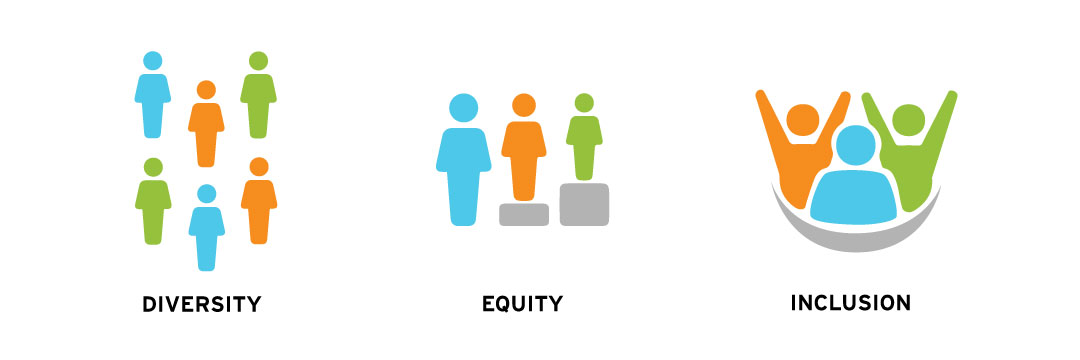Diversity, Equity, and Inclusion (DEI) in Campus Planning

The pandemic presented higher education with unprecedented challenges. After years of remote learning, universities are looking to re-engage students and rebuild campus culture.
Rebuilding campus culture comes with a renewed focus on Diversity, Equity, and Inclusion (DEI). The pandemic highlighted disparities among students—especially in terms of race, ethnicity, socio-economic status, and ability—and universities are looking for solutions.
Addressing disparities requires new policies and procedures—and a new approach to campus planning. Although we often think of buildings as “neutral,” they have the power to shape institutional cultures for years to come.
Recent research has shown that an inclusive design process can lead to design solutions that better address social and economic inequalities. This article will discuss the problems with conventional campus planning and how to create a design process that better aligns with DEI initiatives.
DEI in Higher Education
Higher education is a key pathway for social mobility in the United States, but not everyone has equal access. Historically, the US has seen racial and ethnic disparities in higher education enrollment and attainment—leading to gaps in employment and earnings for communities of color.
Diversity, Equity, and Inclusion (DEI) initiatives are one response to these disparities. Although DEI is often used as a blanket term, it represents three goals.
Diversity is the presence of differences, including differences in:
- Race
- Ethnicity
- Gender
- Religion
- Sexual orientation
- Nationality
- (Dis)ability
- Political perspectives
Equity is the promotion of impartial and fair procedures, processes, and distribution of resources; inclusion refers to the degree to which individuals can participate in decision-making processes and development opportunities.
Combined, these efforts promote an environment that welcomes differences, as well as policies and practices that address disparities and injustices.
DEI initiatives also improve the quality of education. Introducing students to different cultures and ideas prepares them for a global, multicultural world.

Potential Issues with Conventional Planning
Buildings have the power to shape institutional cultures, but conventional approaches to campus planning often neglect the voices of underserved communities. Whether in terms of gender, race, ethnicity, or (dis)ability, the voices at the planning table may not accurately reflect the makeup of the students, staff, and faculty.
According to Amara H. Perez, Ph.D., a social justice researcher, campus planners often adopt a “colorblind” mentality. Space is assumed to be neutral and free of cultural biases and power structures.
However, this attitude ignores the diverse experiences of individuals on university campuses.
A lack of diversity in the planning process is a missed opportunity for a more nuanced understanding of the connection between design and culture. It limits the potential for campus design to contribute to educational equity and upholds the status quo.
Architects should work with higher education institutions to bring together diverse voices, engage in meaningful inquiry, and help cultivate a shared vision.
Incorporating Diversity in the Planning Process
Whether creating a master plan or renovating an existing facility, it’s important to bring stakeholders together to cultivate a shared vision. Often, this is accomplished through visioning workshops and planning sessions that include:
- Administrators
- Faculty
- Staff
- Students
When designing with DEI in mind, including different user groups is not enough. It is also important to think about the diversity of each group and find ways to engage those most affected by social inequalities.
Architects should also think critically about the questions asked during planning sessions. While functional questions about spatial needs are necessary, they may fail to address social and cultural issues.
Perez argues for a framework that situations material needs into a larger social context. Architects should strive to develop a line of inquiry that addresses four categories:
- Functional: institutional programs and space usage
- Experiential: How communities perceive space based on social identity and experience
- Relational: Relationships between people and programs, programs and institutions, and institutions and local communities
- Cultural: Spatial features of belonging, equity, and inclusion
The goal is to promote new ways of thinking and cultivate design solutions that benefit all. In short, there is no one “right” way to design a building or plan a campus. Through diverse participation and intentional inquiry, we can form a vision for college campuses that better aligns with the goals and experiences of the students and staff.
Learn More About Campus Planning
DEI is a foundational component of many organizations—especially higher education institutions. However, the role of design is often overlooked. Buildings can shape institutional cultures, and they should be designed with DEI in mind.
Design solutions will look different in every context. An architect’s job is to listen to input, develop solutions that align with occupants’ needs, and anticipate future changes and challenges. The goal is to engage a diverse group of occupants and ask questions that address the link between buildings and culture.
Rebuilding campus culture is not the only challenge facing universities after the pandemic. Many universities are also working to provide better mental health support and respond to new modes of work. Learn more by reading about how an architect’s perspective can address these challenges.